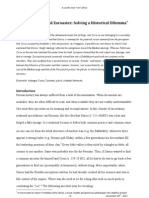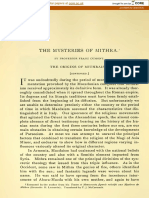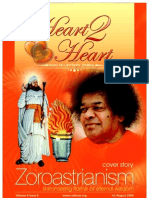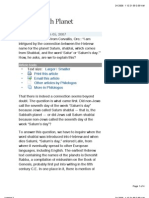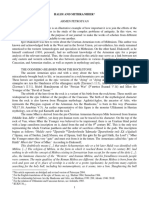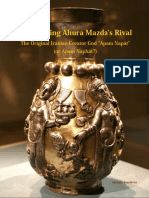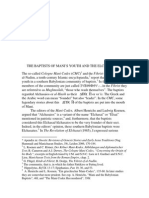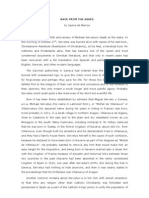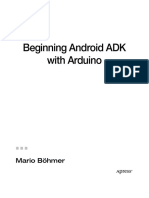Schwartz - 2009 - Apollo and Khshathrapati The Median Nergal at Xanthos
Schwartz - 2009 - Apollo and Khshathrapati The Median Nergal at Xanthos
Uploaded by
Farhad AslaniCopyright:
Available Formats
Schwartz - 2009 - Apollo and Khshathrapati The Median Nergal at Xanthos
Schwartz - 2009 - Apollo and Khshathrapati The Median Nergal at Xanthos
Uploaded by
Farhad AslaniOriginal Description:
Original Title
Copyright
Available Formats
Share this document
Did you find this document useful?
Is this content inappropriate?
Copyright:
Available Formats
Schwartz - 2009 - Apollo and Khshathrapati The Median Nergal at Xanthos
Schwartz - 2009 - Apollo and Khshathrapati The Median Nergal at Xanthos
Uploaded by
Farhad AslaniCopyright:
Available Formats
145
Prods Oktor Skjrv is distinguished not only by
his broad range of expert erudition in Iranistics
and his service to this eld through both prolic
publications and pedagogical aids, but also by his
collegiality, including private and public open-
ness to opposing views. I am condent that he
will welcome my contribution to this celebra-
tion even though I will differ with him, as also
with other notable Iranists, in the solution of the
problem to which this paper is addressed.
An Old Iranian divine epithet Khshathrapati
(
X
s
a
q
rapati-
) Lord of Power/Rule/Dominion is
attested as
s
trpty
in the Aramaic version of the
trilingual stela erected at the Leton of Xanthos,
Lycia, by Pixodaros, the last Achaemenid satrap
of Caria and Lycia (A. Dupont-Sommer in Metzger
et al. 1974 and 1979). The Greek and Lycian ver-
sions of the inscription indicate that it is Apollo
for which Khshathrapati is intended as equivalent.
Since the publication of the inscription four de-
cades ago, the consensus opinion that Khshathra-
pati is Mithra has had a growing dossier of alleged
evidence. The present article is intended to show
that the dossier is unconvincing, and to replace
Mithra by another candidate for Khshathrapati.
The identication of Khshathrapati with Mithra
was primarily motivated by Apollos solarity,
whereby the suggestion arose that the equivalent
Iranian deity with a solar nature was Mithra.
However, the sun was divinized in the Iranian
cult as Huwar Khshaita (Avestan
huuar
x
s
a
e
ta
-).
Mithra was properly a god of social agreements
(including contracts and pacts), whose course of
inspection followed the sun across the sky, and in
the course of the centuries before the Common
Era became a sun-god himself. That this devel-
opment had occurred for the Mithra worshipped
in southwestern Anatolia in the late Achaemenid
period cannot be taken for granted (see Ger-
shevitch 1975).
Two other seeming corroborations of the
Khshathrapati = Mithra theory were noted with
the publication of the stela. The identication
of Khshathrapati with Mithra appeared to have
an auspicious precedent in R. Dussauds view
(see Dupont-Sommer 1976) that the ancient
Levantine god named
s
drp
, later called
Satravph
at Elis in the Peloponnese, is of Iranian origin,
and represents Mithra as Satrap. This opinion,
as, we shall see, was more recently taken up by
A. D. H. Bivar as part of the evidence for Khs-
hathrapati = Mithra. In fact, the attestation of
s
drp
is limited to the greater Phoenician area.
His name is now known to consist of the Se-
mitic
rp
healing, the healer added to Egyp-
tian
s
d
the savior or the enchanter, a form
of Horus who repels vermin, who was brought
by Semitic workmen to the Levant from Egypt,
a provenience conrmed by the Egyptian traits
of the earliest statues of the god from Lebanon
dating perhaps as early as the 9th to 7th cent.
b.c.e.
The Hellenized form
Satrav ph
, attested
in the Phoenician territory (whence the form
in Elis), is but a popular etymology for
s
drp
. See
Schwartz 2006, 146, and 147, notes 815, with
references to E. Lipi
n
ski. This Phoenician di-
vinity is thus irrelevant for both Mithra and
Khshathrapati (
<
x
s
a
q
ra-pati-
, in which the ele-
ment *-
pati
- lord differs from the -
pa
8
-
pro-
tector of *
x
s
a
q
rapa
8
-
satrap).
A more important apparent corroboration for
Khshathrapati = Mithra was M. Mayrhofers obser-
vation (
apud
Dupont-Sommer 1976, 653) of a for-
mula, in several Br
a
hma
as, which declares that
Apollo and Khshathrapati, the Median Nergal, at Xanthos
M A R T I N S C H W A R T Z
university of california, berkeley
s c h w a r t z
: Apollo and Khshathrapati, the Median Nergal, at Xanthos
146
Mitra is
k
atrpati
- Lord of Power. This im-
plies that *
x
s
a
q
rapati
- and
k
atrpati
- represent
parallel inheritances from a Proto-Indo-Iranian
epithet *
k
s
atrapati
- for *Mitra. However, no com-
parable Avestan epithet is found for Mithra. One
only nds a structurally different genitive phrase
instead of the compound, and this is for Mazda
Ahura and not Mithra, in the Gathic Yasna
44.9
paiti
s
. . . x
s
a
q
rahii
a
Lord of Dominion/
Power. The compound
k
atrpati
- is not found
in the Rigveda, which however commonly asso-
ciates Varu
a, and thence Mitr
a
varu
a
, with
k
atr
, and this may lie behind the Br
a
hma
as
qualifying Mitra as
k
atrpati
-. Possibly the
Gathic
paiti
s
. . .
x
s
a
q
rahii
a
is inherited from a
pre-Zarathustrian Ahura who resembled Varu
a;
such an Ahura is evidenced in the Old Avestan
Yasna Hapta
h
a
iti, in which Mazd
a
Ahuras
aqueous wives, the Ahur
a
n
i
s, parallel Varu
as
Varu
a
n
i
s, and in the Gathas themselves, not
to be deceived is the all-binding (
v
i
sp
a
.hi
s
as
)
Ahura, as Yasna 45.4e is correctly translated.
The lack of Iranian evidence for Mithra being
x
s
a
q
rapati
- was impressively addressed by P. O.
Skjrv (in Humbach and Skjrv 1983, 99
100), who derived the name of the Manichean
divinity
()x
s
()y
s
pt
etc. from *
x
s
a
q
rapati
-, com-
paring as mythological equivalent Man. Middle
Persian
dahybed
Lord of the Land/Country
(also attested as a Sasanian title of a ruler), one of
the Sons of Mihr-yazd (= the god Mithra).
Sims-Williams (
apud
Boyce 1990, 7 n. 7) showed
that the Sogdian must represent
(
)X
ses
-pat
, and
attempted to explain the rst element as *
x
s
ai
q
ra
-
via contamination of
x
s
a
q
ra
- land, dominion by
*
s
ai
q
ra
- (Avestan
so
iqra-) dwelling or via the
root-form xsai- to rule. Sims-Williams evidence
for *xsaiqra- is unsustainable. R. Schmitts expla-
nation of the Elamite divine name Setrabattis
(rejecting as impossible etymology from *xsaqra-
pati-) from a straightforward saiqrapati- Lord of
the Dwelling/Settlement (pace Sims-Williams,
where Schmitt is cited) is corroborated by a
Young Avestan divine appellation soiqrahe paiti-
(Yasna 2.16), whereas *xsaqrapati- still requires
support. Sims-Williams other arguments for
*xsaiqra- are unconvincing. The form of Greek
ejxaitravph etc. (vs. satravph < *xsaqrapa8 sa-
trap) could be inuenced by ejxaiten to com-
mand, cf. Late Latin admiralis < Arabic amir
(? al-) via admirabilis or the like. Man. Parth.
rdxsyhr, Persian rdsyr, derive from *Artaxsa-
qr(i)ya-, indicated as rtstry on Frataraka coin-
age, cf. Book Pahlavi ptsyl etc. vis--vis Inscrip-
tional Pahl. ptstry treaty < *patixsaqriya-.
Tumshuq Saka xsera-, Khotanese kira- coun-
try, land, kingdom could formally derive from
*saiqra- with semantic inuence of xsaqra-.
However, the thesis of an etymological paral-
lelism between Sogd. ()Xses-pat and MPers.
dahybed fails for reasons of Manichean Middle
Iranian realia. It is only in the Middle Persian
that Manis original Aramaic conception of Liv-
ing Spirit and his ve emanations was trans-
lated (in Manis presentation of his ideas to the
Zoroastrian king Shapur I) as the god Mithra and
his ve sons, the rst four of whom are named
from the Zoroastrian Pahlavi series manbed,
wisbed, zandbed, and dahybed, which render a
series of four lords (Av. -paiti-) over a fourfold
hierarchy (house, clan, tribe, land/country) asso-
ciated with Mithra in his Avestan hymn, to
which series pahr(ag)bed border lord was
added. It must be noted that neither the Living
Spirit nor the Splenditenens is ever connected
with Mithra in Man. Sogd. texts; Mithra, Man.
Sogd. mysyy bgyy, is merely the Sun.
In Sogdian Manicheism, the equivalents of
Manis mytholegoumena are rendered quite dif-
ferently from the Middle Persian, and in general
translate or approximate Manis original concep-
tions. Thus the Living Spirit is not named from
Mithra (unlike the MPers., where Mihryazd =
the Living Spirit)
1
but is directly translated Zu-
wande Griw Living Spirit (~ Wad Ziwande/
Ziwandag < Parthian id.) or is approximated as
Wesparkar, the local name of the Old Iranian at-
mospheric god (Av. Vaiius Uparo.kairiio). Simi-
larly the Sogdian names of the emanations of the
Living Spirit. Manis Adamas of the Light, who
has a martial role, becomes Sogd. Wsagn, the old
god of victory in warfare. Manis King of Honor
becomes Sman Xsed/Xseq Heaven King, while
the Glorious King, who stands on the lowest
earth, is named Zay Spandarmet the Earth
(goddess) Spandarmet.
In this light, the Atlas problematic Sogdian
name, pdfrbgyy, which appears to mean the god
who causes rushing, could be explained by a
conception of Atlas (in Man. Gr. Wmofovro
Bearing [the earth] on the shoulders, Syr. Sab-
bala the bearer) as making the earth(s) whirl
on his shoulders. Such a view may have arisen
from the at round shape of the earth borne aloft
147
s c h w a r t z: Apollo and Khshathrapati, the Median Nergal, at Xanthos
being associated with the rmament, Sogd. qfarte
(Psalm 19.1 dbrty = Syr. rqia), the cognate of Av.
qbas5a- (< *qwrta-) rushing and rmament
(Schwartz 1974, 260) the latter word glossed in
Persian as xub-carx well-wheeled, cf. Pers.
carx-i falak the (whirling) wheel of the rma-
ment, sometimes expressed by carx alone. The
association of the bearer of the earth with a
twirler of rmaments may have been maximized
by the Manichean myths placement of the
wheels of re, water, and wind close to the Atlas.
Quite possibly the concept of the Atlas was ap-
proximated by an old local Sogdian divine cos-
mological wheel-turner; cf. Henning 1937, 5960
n. 506, who connects pdfrbgyy with speeding
and suggests that a local Sogdian god is behind
the identication.
Now, Sogd. ()Xses-pat (whose appellation must
be independent of that of its MPers. mythic equiv-
alent, the Lord of the Country) names that ema-
nation which Mani, in his original Aramaic,
called the Holder/Possessor of Splendor, which
is found in the Syriac tradition (in Ephraem
Syrus Prose Refutations and independently in
Theodore bar Qoni), in Greek (Feggokavtoco), and
in Latin (Augustines Splenditenens).
2
Accordingly, with -pat lord, possessor,
*()xses should mean splendor. From Proto-
Iranian *xsaita- splendid, bright, attested in
Av. xsaeta- id. (e.g. in huuarxsaeta- the Sun
as bright; Ossetic Digorun xsed dawn-ruddy;
and Pers. sed brightness), we may posit Old
Sogdian *xsaiqya- (with regular *-qya- from der-
ivational *-t-ya- still operative after cessation of
Sievers Law); for *-qy- to Sogd. -s-, see Henning
1937, 63 n. 523.
3
A. D. H. Bivar (1988 passim; 1998, 1230) has
built on the Khshathrapati = Mithra theory, tak-
ing up again the old Iranizing explanation of the
name of the Phoenician god sdrp/Satravph (dis-
missed above), and making use of Skjrvs ety-
mology of ()Xses-pat in putting forth a novel
Iranizing explanation of the Hellenistic god Sa-
rapis (Serapis) which has eluded Iranistic criti-
cism and which I must address here.
Bivar moves from the Xanthos Xsaqrapati-,
allegedly Mithra, to Skjrvs derivation of
()Xses-pat from *Xsaqrapati-. However, he ig-
nores Skjrvs correct equation of ()Xses-pat
with Dahybed (= the Splenditenens). Citing the
series of ratu-s (chief representations) in the Pah-
lavi translation of Yasna 19.9, which had been
adduced by Sundermann as the source of Manis
rendering of the ve emanations of the Living
Spirit as the Five Sons of Mithra, Manbed (Lord
of the House), Wisbed (Lord of the Clan),
Zandbed (Lord of the Tribe), and Zardust (Zar-
athushtra) is the Fifth, Bivar focuses on the last
item. He expects that Zoroaster is a Zoro-
astrian replacement for an original Sahrbed <
*Xsaqrapati- Lord of the Kingdom/Empire in a
series from Median Mithraism in which Xsaqra-
pati-, as designation of an imperial Mithra, was
sacrilege for Zarathushtra as well as for Mani,
who changed Sahrbed to Pahr(ag)bed to name
the highest ranking son.
4
The latter son, it must
be noted, is the King of Honor, and not the Holder
of Splendor. Moreover, it is clear that the Avestan
hierarchy is a fourfold canon, nmana- house,
vis- clan, zatu- tribe, and dai! hu- land;
the West Iranian imperial use of xsaqra- is a later
development, and it is absurd to posit a Median
ideology which is older than that of the Avesta.
More relevantly yet, Bivar invents a word, sahr-
bed, and treats it as a real entity, although it is
attested in no form in Middle Persian. It is the c-
tive Sahrbed (< Xsaqrapati-), allegedly Mithra as
god of the (Median) state, which Bivar then posits
as the origin of the Hellenistic god Sarapis, hith-
erto regarded as Egyptian.
Unfortunately, Bivars theory was given re-
spectability by N. Sims-Williams (apud Boyce
1990, 7), whereby Boyce (op. cit.) was inclined
to regard the theory as credible. Sims-Williams
bypasses the ctive Sasanian MPers. sahrbed,
obviously anachronistic in phonology as a source
of the early Hellenistic Sarapis, and opines in-
stead that Sarapis from Xsaqrapati- is possible
via an early sporadic *-hr- < *-qr-, citing forms
like Elam. Irdaksara, Gr. rtoxavrh, Babylonian
Ar-tah-s-ri from Artaxsqra-. Such evidence is
inconclusive, since neither the cuneiform lan-
guages nor early Greek had a sound q (dental
fricative), so that *q could have been approxi-
mated as *hr (Greek rtoxavrh may have en-
tailed dental dissimilation as well). It is notable
that the alleged substandardism does not occur
in texts in Aramaic (which could indicate q). And
why should a substandard form be used for the
gods cultic name abroad?
The fact is that there is no reason whatsoever,
ideological or iconographic, to derive Sarapis
from Iran, let alone from Mithra. In greater Iran
it is only among the Bactrians that the cult of
s c h w a r t z: Apollo and Khshathrapati, the Median Nergal, at Xanthos
148
Sarapis ourished, and here SARAPO (with s- and
not s-) is clearly from the Greek. The magisterial
study of Stambaugh 1972 (ignored by Bivar)
should leave no doubt of the Egyptian prove-
nience of Sarapis. From linguistic and textual
considerations it is clear that this divine name
is from Greek (< Late Egyptian compound of
Osiris + Apis) OSERAPIS (also OSORAPIS),
metanalysed as O *SERAPIS, O *SORAPIS, fur-
ther supported by papyrological evidence from
the middle of the 4th century b.c.e. (see Stam-
baugh 1972, 5 and 11) and by iconographic evi-
dence and Classical testimonia (Stambaugh 1972,
6, 44, 52, 61 and passim). It may be added that
the oblique form Sarapid-, whose nal dental
was compared by Bivar with that of his ctive
sahrbed < *Xsaqrapati-, is based on pid-, cf.
Isid-, Osirid-, etc.
Thus the entire series of divine names similar
to Xsaqrapati- Phoenician sdrp/Satravph, Man.
Sogd. ()Xses-pat, and Greco-Egyptian Savrapi
is merely due to coincidence. One may compare
(among many such banal random similarities
among names of gods as Akkad. Assur: Vedic
sura-); the Phoenician Melqart: Corinthian
Melikevrth; and West Semitic Dagan, Dagon:
Southern Nuristani Dagon, Dagan.
5
It has been seen that no Iranian data support
the thesis that at Xanthos Mithra lies behind the
isolated occurrence of Khshathrapati. Nothing,
moreover, accounts for the putative substitution
there of the name Khshathrapati for Mithra (a
god who, as his hymn [Yt. 10.56] stresses, must
be addressed by his proper name).
The new solution for the identication of
Khshathrapati on the Xanthos stela will emerge
more clearly after a new consideration of the
Greek and Aramaic aspects of the inscription.
Rather than mention Apollo (and Artemis) ex-
plicitly, the Greek text speaks of Leto and her
progeny, which reects the centrality of Leto,
into whose sanctuary Pixodaros, as per the in-
scription, imported the cult of a god of Kaunos
from Caria. Leto was of particular importance at
Xanthos as patroness of the Lycian Confedera-
tion. Her cult at Lycia was distinguished by her
presiding over graves (Burkert 1985, 172). To this
chthonic prole of the goddess may be added
that the Greek inscription mentions, after Leto
and her progeny, the Nymphs, who represented a
local volatile spring which (during Alexanders
lifetime, according to Plutarch) spontaneously
upheaved from its depths (and cast forth a tab-
let inscribed in ancient letters! See citation in
Boyce 1990, 9 n. 38). Letos daughter Artemis (for
whom no Iranian equivalence was at hand) was
associated with the realm of death as mistress of
cruel and bloody sacrices, and like Apollo (see
below) as shooter of arrows (Burkert 1985, 152).
Now to Apollo himself. The Aram. juxtaposi-
tion rtmws strpty provides the names of the
sibling pair called in Greek the progeny of
Leto, and we may now see strpty (= Apollo),
and not *strptys = xsaqrapatis (nominative), as
reecting a grammatical linkage in the Old Ira-
nian phrasing which lies behind the Aramaic:
xsaqrapati, instrumental case, (together) with
Khshathrapati. Humbach (1981, 33) took strpty
as a frozen vocative.
The larger context, in which Khshathrapati is
mentioned alongside Artemis in series with the
Abyss, Leto, and the Nymphsall chthonic
would point to a chthonic aspect of Apollo which
is reected in his translation as Khshathrapati.
Now, Apollo in western Anatolia had chthonic
associations due to his presiding over healing
via incubation in articial grottoes called Char-
oneia (or Plutoneia). The most famous Charon-
eion, admiringly described by Strabo three centur-
ies after Pixodaros erected his inscription, was
at Characa, in the Carian homeland of Pixodaros.
Apollo became a sun-god only gradually, origi-
nally being an underworld god. The foregoing
local circumstances would have tended to pro-
long Apollos older chthonic nature, his being
understood as a sun-god in the Greek world grad-
ually taking place from the 5th century onwards
(Burkert 1985, 149).
Apollos sojourns in the underworld, his close
relation to obscurity and death, and his shoot-
ing arrows of disease, as well as his healing, are
features which make him parallel to the Meso-
potamian underworld god Nergal. Furthermore,
both Apollo and Nergal are represented by ravens,
and are associated with palm trees, snakes, and
lions. Both Apollo and Nergal, in aspects of their
myths, represent the sun in the netherworld. See
Burkert 1985, 149 and 405 n. 22; Kingsley 1999,
8284, 8892, 134, 24243; Bivar 1975, 289.
Now, Nergals name goes back to a Sumerian
phrase Lord of the Great City (Wiggermann
2001, 21819), which refers to a durable Mesopo-
tamian conception of the realm of the dead as a
large urban settlement. This points to the con-
149
s c h w a r t z: Apollo and Khshathrapati, the Median Nergal, at Xanthos
ception of Nergal, as lord of such a realm, being
calqued in Iranian as Xsaqrapati- Lord of the
City (xsaqra- > city in West Iranian).
The necessary evidence for an Iranian nether-
world god *Xsaqrapati- comes from Armenian
materials conveniently brought together in Rus-
sell 1987, 33032. In a digression to Arm. sahap
satrap, Russell mentions the Xanthos Khsha-
thrapati and gives (apparently independently of
Bivar, and without equation with Mithra), a se-
ries of names which we have seen to be irrele-
vant: Satravph (and by implication sdrp); Man.
Sogd. xsyspt (bgw); and Savrapi, adding a sugges-
tion for a Middle Persian etymology of a Coptic
Sasabed, the latter based on a misprint in early
editions of J. R. Robinsons translation of the
Nag Hammadi library; correctly Sasabek). What
concerns us is Russells data on sahapet, a super-
natural being or category of such beings. The ci-
tations from the 13th cent. Oskiberan, in which
various pagan divinities are detailed as sahapet-s
of trees and vines, attest a connection with
vegetation consonant with an ancient chthonic
god. The much older citations from the Classi-
cal Armenian Agathangelos and Eznik indicate
that sahapet is associated with tombs and the
netherworld, as well as with aquatic and terres-
trial reptiles, in particular with serpents, whose
forms the sahapet can assume, leading men to
abandon God for worship of snakes. The latter
details, which imply the worship of a sahapet
intimately connected with snakes, recalls the
iconography of Nergal in the Parthian period at
Hatra, with snakes all around the god and being
part of his accoutrements.
6
We have here evi-
dence of Nergal = sahapet, which must derive
linguistically from *xsaqrapati-, like sahap <
*xsaqrapa8 satrap, hazarapet < *hazarapati-
chiliarch, etc. This conrms that Khshathra-
pati Lord of the (underworld) City/Realm (a
descriptive epithet with the tabuistic advantage
of serving to avoid naming the sinister god) was
modeled after Nergal.
Such a divinity on ancient West Iranian soil
probably lies behind the vague designation of
the god under the earth to whom Xerxes and
Amestris brought human sacrices, according to
Herodotus VII.114. This god, patently non-Zoro-
astrian, would have been brought to Persia by
the Magians as part of their old religion. Thus
Khshathrapati would have come to Persia from
the Magian homeland, Media, and specically
Media Atropatene. This provenience would suit
the northern Mesopotamian history of the Ner-
gal cult, and the origin of the Armenian Sahapet.
Linguistically, too, xsaqrapati- conforms to
Median rather than Old Persian phonology; cf.
the Median PN *Xsaqrita- (Darius, Behistun)
vs. OPers. xsaa- empire, and Arm. sahap <
*xsaqrapa8 satrap vs. OPers. xsaapa8 id.
Specically Median phonology in fact charac-
terizes wrnys = Axuranis the Nymphs,
attested in Old Avestan as Ahuranis (for the
reading wrnys, see Humbach 1981). The non-
Persic xu < hu is shown to be Median by the
name rendered as Greek Kuaxavrh Cyaxares =
*Xuwaxstra- < *Huwaxstra-.
The presence of the Median god Khshathrapati
at Xanthos could be due to the foundation, under
Cyrus dispensation, of the city of Xanthos by
Harpagos the Mede and his retinues, including
troops and their families, inevitably with a rep-
resentation of the Median priesthood, i.e. Magi.
Later on, the continuation of Magian religious
practices would have been tolerated by Darius
(as at Persepolis itself), and even under the later
Achaemenids, with their syncretistic Zoroastri-
anism, there is no reason to think that old local
traditions on the periphery of the empire would
have been opposed, especially in a matter such
as an Iranian rendering for a Greek god in the
context, moreover, of an intrusive satrapal Car-
ian religiosity.
It is due to these circumstances that there is
recoverable at Xanthos a unique trace of the old
Median pantheon: Khshathrapati, the Nergal of
Western Iran.
Notes
1. Boyce 1990, 8 n. 10, wrongly has Keeper of
Splendour instead of the Living Spirit.
2. For the Syriac evidence of Possessor of Splen-
dor in Ephraem and, later, Theodore, see Jackson
1932, resp. 303 and 29697 with fnn.; the intervening
material in Jackson is informative for my discussion
of the ve emanations of the Living Spirit.
3. Sogd. psbr, pysbr provision(s) is better ex-
plained from *paqyabara- that which one brings on
the way; cf. Henning apud Driver 1965, 61.
4. Further material on the Manichean realia may be
seen in the well-indexed Sundermann 2001.
5. It is Dagan on a coin of Mazaeus satrapy. The
cereal god holds an ear of grain, and is identied as bl
s c h w a r t z: Apollo and Khshathrapati, the Median Nergal, at Xanthos
150
dgn the lord Dagan, not bl trz. The coin is from
Syria, not Tarsus (Lemaire 1991, 45, 4751). The coin
has nothing to do with Mithra or Nergal, contra Bivar
1998, 33, and Boyce 1990, 4.
6. For the iconography of Nergal with serpents at
Hatra, see Drijvers 1978, 17475, where remarks rele-
vant to the discussion of Nergal in the present article
are also to be found; Drijvers paper also cogently dis-
misses Bivars identication of Mithra with Nergal.
Bibliography
Bivar 1975 A. D. H. Bivar. Mithra in
Mesopotamia. In Mithraic
Studies, II, ed. J. R. Hinnells,
27589. Manchester.
Bivar 1988 . An Iranian Sarapis.
BAI 2:1117.
Bivar 1998 . The Personalities of
Mithra in Archaeology and
Literature. New York.
Boyce 1990[1992] M. Boyce. Mithra Khsathra-
pati and His Brother Ahura.
BAI 4:39.
Burkert 1985 W. Burkert. Greek Religion.
Translated by J. Raffan.
Cambridge, Mass.
Drijvers 1978 H. J. W. Drijvers. Mithra at
Hatra? In tudes mithri-
aques, ed. J. Duchesne-
Guillemin, 15186. ActIr 17.
Leiden.
Driver 1965 G. R. Driver. Aramaic Docu-
ments of the Fifth Century
B.C. Oxford.
Dupont-Sommer A. Dupont-Sommer. Lnigme
1976 du dieu Satrape et le dieu
Mithra. CRAI, 64860.
Gershevitch 1975 I. Gershevitch. Die Sonne das
Beste. In Mithraic Studies, I,
ed. J. Hinnells, 6879.
Manchester.
Henning 1937 W. Henning. Ein Manichi-
sches Bet- und Beichtbuch.
Berlin.
Humbach 1981 H. Humbach. Die arami-
schen Nymphen von Xanthos.
Die Sprache 27:3033.
Humbach and H. Humbach and P. O. Skjrv.
Skjrv 1983 The Sassanian Inscription of
Paikuli. Pt. 3.2. Wiesbaden.
Jackson 1932 A. V. W. Jackson, Researches in
Manichaeism. New York.
Kingsley 1999 P. Kingsley. In the Dark Places
of Wisdom. Inverness.
Lemaire 1991 A. Lemaire. Notes dpigra-
phie nordouest-smitiques, 28:
Monnaie de Mazda avec
lgende BL DGN. Semitica
40:3954.
Metzger et al. 1974 H. Metzger, E. Laroche, and
A. Dupont-Sommer. La stle
trilingue rcemment dcou-
verte au Lton de Xanthos.
CRAI, 8293, 11525, 13249.
Metzger et al. 1979 H. Metzger, E. Laroche,
A. Dupont-Sommer, and
M. Mayrhofer. Fouilles de
Xanthos, VI: La stle trilingue
du Lton. Paris.
Russell 1987 J. R. Russell. Zoroastrianism
in Armenia. Cambridge, Mass.
Schwartz 1974 M. Schwartz. Sogdian Frag-
ments from the Book of
Psalms. Altorientalische
Forschungen 1:25563.
Schwartz 2006 . From Healer to Hyle:
Levantine Iconography as
Manichean Mythology.
Journal of Inner Asian Art
and Archaeology 1:14547.
Stambaugh 1972 J. Stambaugh. Sarapis under
the Early Ptolemies. Leiden.
Sundermann 2001 W. Sundermann. Manichaica
Iranica, ed. C. Reck [et al.].
Rome.
Wiggermann 2001 F. A. M. Wiggermann. Ner-
gal. In Reallexikon der Assyr-
iologie, IX, 21523. Berlin.
You might also like
- Folk Magic and Protestant Christianity in AppalachiaDocument35 pagesFolk Magic and Protestant Christianity in AppalachiaViktorija Briggs100% (6)
- Manfred Clauss The Roman Cult of MithrasDocument2 pagesManfred Clauss The Roman Cult of MithrasdejanveNo ratings yet
- Julius Evola - The Concept of InitiationDocument21 pagesJulius Evola - The Concept of InitiationAN NXNo ratings yet
- Zoroastrian - Vendidad Sadeh - YasnaDocument91 pagesZoroastrian - Vendidad Sadeh - YasnaBahaIQ Search EngineNo ratings yet
- Provanzano, Carlo - The Mysteries of Mithra - Tracing Syncretistic Connections To The Ancient Near East. Ph.D. Dissertation.-California State University (2009) PDFDocument148 pagesProvanzano, Carlo - The Mysteries of Mithra - Tracing Syncretistic Connections To The Ancient Near East. Ph.D. Dissertation.-California State University (2009) PDFGabrielzyxNo ratings yet
- Yazidis: Yazidis (Also Written As Yezidis (/JDocument35 pagesYazidis: Yazidis (Also Written As Yezidis (/JAliNo ratings yet
- Doctrine of CondemnationDocument4 pagesDoctrine of Condemnationthelightheartedcalvinist6903100% (2)
- Sorted Books For WebsiteDocument54 pagesSorted Books For Websiteapi-857238590% (1)
- Transforming Mythic EuropeDocument144 pagesTransforming Mythic EuropeConstantin Bucur100% (3)
- SOUDAVAR Astyages Cyrus and ZoroasterDocument61 pagesSOUDAVAR Astyages Cyrus and ZoroasterIsrael Campos100% (1)
- Mithraism A Religion For The Ancient MedesDocument19 pagesMithraism A Religion For The Ancient MedesAnitaVasilkova100% (1)
- Solinvictus Press: Fine Press Books Livres de Peintre One-Of-A-Kind BooksDocument32 pagesSolinvictus Press: Fine Press Books Livres de Peintre One-Of-A-Kind Booksstefan arteniNo ratings yet
- MithraDocument4 pagesMithraMathieu RBNo ratings yet
- Jesus Vs MithraDocument2 pagesJesus Vs MithraStefan LaemersNo ratings yet
- Georgia and Iran Three Millennia of CultDocument43 pagesGeorgia and Iran Three Millennia of CultDavidAbulashviliNo ratings yet
- Mysteries of MithraDocument9 pagesMysteries of MithraAnu HasanNo ratings yet
- Zoroastrian Survivals in Iranian FolkloreDocument12 pagesZoroastrian Survivals in Iranian Folklorezzz222222No ratings yet
- The Concept of MithraDocument7 pagesThe Concept of MithraLalaylaNo ratings yet
- ManasataramginiDocument19 pagesManasataramginiHarihara KrishnanNo ratings yet
- Peterson Joseph H. - Khorda AvestaDocument230 pagesPeterson Joseph H. - Khorda AvestaGigelNo ratings yet
- Gelation of Gellan A ReviewDocument39 pagesGelation of Gellan A Reviewmithra0% (1)
- Mithra On Kanishka and Huviska CoinsDocument22 pagesMithra On Kanishka and Huviska CoinsEmilia SmagurNo ratings yet
- Archaelogical Indications On The Origins PDFDocument11 pagesArchaelogical Indications On The Origins PDFAnonymous aiLmhVbNo ratings yet
- The Other Side of Deception (PDFDrive)Document169 pagesThe Other Side of Deception (PDFDrive)Alexandru Nicolae GrigorașNo ratings yet
- Rumor and The Roman Religions by April Rose FaleDocument17 pagesRumor and The Roman Religions by April Rose FaleApril RoseNo ratings yet
- The Templars and Baphomet Part 1Document7 pagesThe Templars and Baphomet Part 1MvimaedivmBNo ratings yet
- G.R.S. Mead - Echoes From The Gnosis Vol. V - Mysteries of MithraDocument101 pagesG.R.S. Mead - Echoes From The Gnosis Vol. V - Mysteries of MithraNico Ouwehand100% (1)
- On The Legend of SmamitDocument1 pageOn The Legend of SmamittimNo ratings yet
- Vol4 Issue08 With ImagesDocument146 pagesVol4 Issue08 With Imagesapi-3701385No ratings yet
- The Symbolism of Bertha MasonDocument2 pagesThe Symbolism of Bertha MasonVessy TomovaNo ratings yet
- Dajjaal ReducedDocument128 pagesDajjaal ReducedJamaatu-l-FitrahNo ratings yet
- Freemasonry - Mystery of MithraDocument4 pagesFreemasonry - Mystery of Mithrawez99No ratings yet
- Kurdish Studies 4 2 Special Issue YezidiDocument9 pagesKurdish Studies 4 2 Special Issue YezidiankasoteckaNo ratings yet
- Sabbath Planet Jordan Max WellDocument4 pagesSabbath Planet Jordan Max WellThea NedelchevaNo ratings yet
- Mithra in Roman OrientDocument19 pagesMithra in Roman OrientIsrael CamposNo ratings yet
- (D.Ulansey) Cosmic Mysteries of Mithras Mithraism Ancient ReligionDocument19 pages(D.Ulansey) Cosmic Mysteries of Mithras Mithraism Ancient Religionuchujaro100% (1)
- Vermaseren The Miraculous Birth of MithrasDocument21 pagesVermaseren The Miraculous Birth of MithrasAcca Erma SettemontiNo ratings yet
- Haldi and Mithra Mher PDFDocument11 pagesHaldi and Mithra Mher PDFAlireza EsfandiarNo ratings yet
- M. Boyce, Atash Zohr and Ab ZohrDocument20 pagesM. Boyce, Atash Zohr and Ab ZohrLalaylaNo ratings yet
- The Legacy of MithraismDocument11 pagesThe Legacy of MithraismMathieu RBNo ratings yet
- Discrediting Ahura Mazda S Rival The Ori PDFDocument91 pagesDiscrediting Ahura Mazda S Rival The Ori PDFimperatorgothicusNo ratings yet
- The History of The Origin Sigil of BaphometDocument11 pagesThe History of The Origin Sigil of BaphometDaniel de La ONo ratings yet
- The Eyes of Goats and of Women FemininiDocument22 pagesThe Eyes of Goats and of Women Femininiwanda TupiNo ratings yet
- The Parasurama Myth - Prof MM NinanDocument5 pagesThe Parasurama Myth - Prof MM NinanBharat ShahNo ratings yet
- ZostrianosDocument30 pagesZostrianosJoão Pedro FelicianoNo ratings yet
- The Baphomet, 1998, Pierre Klossowski, 1568860560, 9781568860565, Marsilio Publishers, 1998Document21 pagesThe Baphomet, 1998, Pierre Klossowski, 1568860560, 9781568860565, Marsilio Publishers, 1998GalaxRodríguezNo ratings yet
- Baphomet: Vamperess of The Dark GodsDocument2 pagesBaphomet: Vamperess of The Dark GodsAlice vythica100% (1)
- Crist & Indian GodDocument81 pagesCrist & Indian GodHarish Kumar MahavarNo ratings yet
- Stothers Unidentified Flying Objects in Classical AntiquityDocument15 pagesStothers Unidentified Flying Objects in Classical AntiquityRalph McTinklesteinNo ratings yet
- Dumuzid È TamuzDocument9 pagesDumuzid È TamuzIrmãoIaorrúchuaNo ratings yet
- Ancient Nuclear WeaponsDocument3 pagesAncient Nuclear Weaponssatan_sent_meNo ratings yet
- v2n05 May 1919 LiberatorDocument51 pagesv2n05 May 1919 LiberatorCameron Willis100% (2)
- Dec 25 Mithra Yalda-Nov 2016-AbridgedDocument49 pagesDec 25 Mithra Yalda-Nov 2016-AbridgedKEEduljee100% (1)
- The Secret Architecture of Our Nation's CapitalDocument7 pagesThe Secret Architecture of Our Nation's CapitalRickNo ratings yet
- Mithraism: See BelowDocument5 pagesMithraism: See BelowJOSÉ MANUEL SILVERO A.No ratings yet
- WWW Truthbeknown Com Mithra HTMDocument31 pagesWWW Truthbeknown Com Mithra HTMTulio GarneloNo ratings yet
- Seven Mithraic Grades: An Initiatory or Priestly Hierarchy?: Ale ChalupaDocument13 pagesSeven Mithraic Grades: An Initiatory or Priestly Hierarchy?: Ale ChalupaTóth AndrásNo ratings yet
- I Desire Truth Than FaithDocument9 pagesI Desire Truth Than FaithChimwemwe KuwahaNo ratings yet
- Swastika Constellation in The Sky... Very AncientDocument16 pagesSwastika Constellation in The Sky... Very AncientLuis Vizcaíno100% (1)
- Sheikh Abdul Aziz Ibn MyattDocument638 pagesSheikh Abdul Aziz Ibn MyattUgjtlNo ratings yet
- Kushite IndiansDocument832 pagesKushite IndiansAsarNo ratings yet
- Mithra - WikipediaDocument28 pagesMithra - WikipediaOzhenNo ratings yet
- AnahitaDocument15 pagesAnahitamindhunt100% (1)
- Scythian Elements PDFDocument8 pagesScythian Elements PDFmehdiNo ratings yet
- Lim - 2008 - The Nomen Manichaeorum and Its Uses in Late AntiquityDocument34 pagesLim - 2008 - The Nomen Manichaeorum and Its Uses in Late AntiquityFarhad Aslani100% (1)
- BeDuhn - 2009 - Augustine Accused - Megalius, Manichaeism, and The Inception of The ConfessionsDocument41 pagesBeDuhn - 2009 - Augustine Accused - Megalius, Manichaeism, and The Inception of The ConfessionsFarhad AslaniNo ratings yet
- The Baptists of Mani's Youth and The ElchasaitesDocument15 pagesThe Baptists of Mani's Youth and The ElchasaitesFarhad AslaniNo ratings yet
- The Absolute Dualism of ManiDocument14 pagesThe Absolute Dualism of ManiFarhad AslaniNo ratings yet
- Jackson - 1985 - The Meaning and Function of The Leon To Cephaline in Roman MithraismDocument30 pagesJackson - 1985 - The Meaning and Function of The Leon To Cephaline in Roman MithraismFarhad Aslani100% (1)
- Christianismi Restitutio (Restitution of Christianity), at His Feet, A Heretical Book ForDocument6 pagesChristianismi Restitutio (Restitution of Christianity), at His Feet, A Heretical Book ForJaume De Marcos AndreuNo ratings yet
- Nick VujicicDocument3 pagesNick VujicicDekzie Flores Mimay100% (1)
- Booklet - Haydn - The Complete Mass Edition - HickoxDocument22 pagesBooklet - Haydn - The Complete Mass Edition - HickoxNgan Bui100% (1)
- O L D T E S T A M E N T: Twelve Minor ProphetsDocument2 pagesO L D T E S T A M E N T: Twelve Minor ProphetsAllison Nadine MarchandNo ratings yet
- 30-1 011Document12 pages30-1 011Monika PršaNo ratings yet
- English Corner 1Document5 pagesEnglish Corner 1Tatjana LipovacNo ratings yet
- Umconnection Aug2014Document12 pagesUmconnection Aug2014Alison BurdettNo ratings yet
- Damien Ryan - Hamlet's Unweeded GardenDocument4 pagesDamien Ryan - Hamlet's Unweeded GardenHenry WuNo ratings yet
- Celtic CultureDocument17 pagesCeltic CultureMaria Roberta Cappelletti100% (1)
- 1878 Ferdinand KingstonDocument8 pages1878 Ferdinand KingstonDavid KingstonNo ratings yet
- Review of Ernest Best's Temptation and PassionDocument6 pagesReview of Ernest Best's Temptation and PassionAllysonPresswoodNanceNo ratings yet
- Spiritual AssessmentDocument4 pagesSpiritual AssessmentArlyn CastroNo ratings yet
- Chesterton The Theologian by Bernard Lonergan S.J.Document3 pagesChesterton The Theologian by Bernard Lonergan S.J.thrtyrsNo ratings yet
- Essay On Independence of NepalDocument2 pagesEssay On Independence of Nepallittle bunny foo fooNo ratings yet
- 3rd Quarter 2015 Lesson 7 Powerpoint With Tagalog NotesDocument22 pages3rd Quarter 2015 Lesson 7 Powerpoint With Tagalog NotesRitchie FamarinNo ratings yet
- The Winning Walk June 2015Document4 pagesThe Winning Walk June 2015Nikki DabneyNo ratings yet
- Carolingian AgeDocument41 pagesCarolingian AgeAmber MorseNo ratings yet
- Stjohniii 16 Inmos 00 LondDocument64 pagesStjohniii 16 Inmos 00 LondИван БорщевскийNo ratings yet
- Great Compline Service BookDocument20 pagesGreat Compline Service BookMarguerite PaizisNo ratings yet
- The Burning PlainsDocument25 pagesThe Burning PlainsChanel RobeNo ratings yet
- Acts Prayer FormatDocument4 pagesActs Prayer FormatShiela Ricafranca SabularseNo ratings yet
- Psalms, Hymns and Spiritual Songs: The Music of Early Oneness BelieversDocument4 pagesPsalms, Hymns and Spiritual Songs: The Music of Early Oneness BelieversRossNo ratings yet
- Ah19940401 V16 02Document48 pagesAh19940401 V16 02Brendan Paul ValiantNo ratings yet
- 14th Sunday of Ordinary Time MassDocument109 pages14th Sunday of Ordinary Time Masstonton OlitaNo ratings yet
- Beginning Android ADK With ArduinoDocument308 pagesBeginning Android ADK With ArduinoGustavo Carnevali MendesNo ratings yet
- Advent of A National HeroDocument27 pagesAdvent of A National HeroPaolo Obrero PilarNo ratings yet









